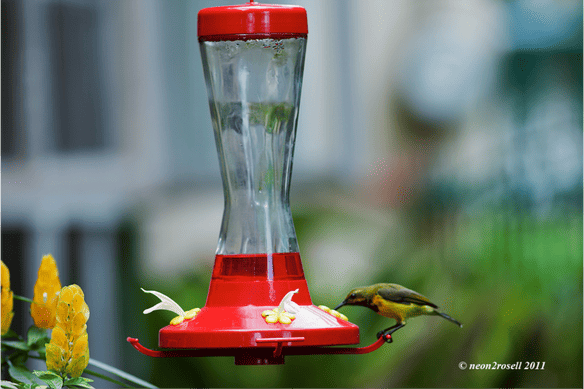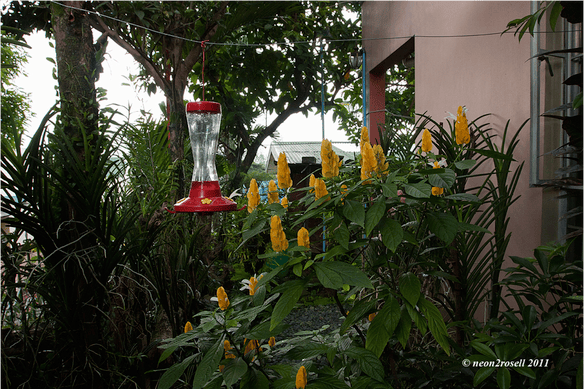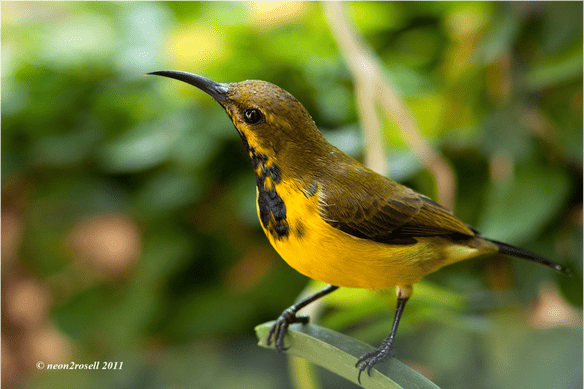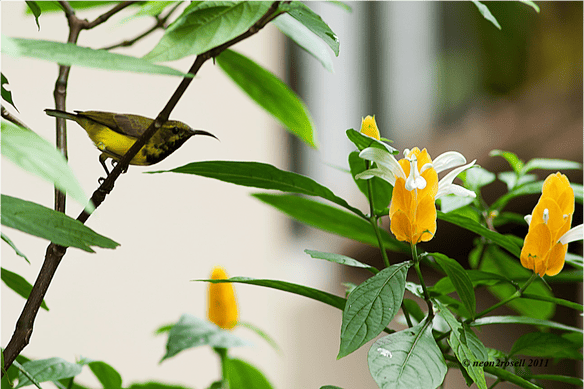Hummingbird feeders are common in the USA but not in the Philippines. Neon Rosell is curious to find out whether an Olive-backed Sunbird will feed from a hummingbird feeder. Read the article to find the answer.
SETTING UP A GARDEN SUNBIRD FEEDER
text and photos by Neon Tomas B. Rosell II
Taking the knowledge from hummingbird feeding bottles used by bird lovers from the Americas and putting these ideas to good use, I wanted to find out if a similar setup can be arranged to work with the native sunbird species we have here in the Philippines. In this particular case the Olive-backed Sunbird Cyniris jugularis was the subject bird species for this little experiment.
There is little known understanding about supplemental feeding of wildlife in the Philippines and this is probably one of the first tries for such. With more people becoming aware of environmental concerns like protection and biodiversity, less wildlife are being harmed resulting to increases in population of individual species. This increase in population is not at pace with habitat regeneration resulting in diminished carrying capacity for a given area. If done on one of the primary consumers, supplemental feeding will have little impact on the environment as its population is easily controlled by the amount of food available. These small birds are prey to much larger secondary species (Shrike, Goshawk, etc.) which are migratory in nature . If the population of this small species is initially low and they are subsequently preyed upon, this population would be greatly diminished. Recovering from such devastation would be hard if initial numbers are quite low.
Wildlife will be more readily available for appreciation when it is visible and approachable. There is the fear that when wildlife gets too familiarized with the people, the wildlife will be harmed by the people. However, it is not as bad as what it seems. Peoples’ mind sets will also evolve as both humans and wildlife, in this case, sunbirds, interact. Further studies are really needed to get a better understanding of this kind of feeding and the actual impact in local settings.
Both hummingbirds and sunbirds take nectar from flowers as one of the main food in its diet. It seemed likely that the native sunbirds would take artificial nectar from hummingbird feeding bottles as well. To shorten the learning process and develop a local way or system to attract the sunbirds, a tried and tested feeding bottle and nectar formula used for humming birds in North America was procured. The feeding bottle with perches were used as the nature of sunbird feeding is different from the hummingbirds. Humming birds hover while sunbirds, although they sometimes hover, typically perch when feeding.

The bottle with the nectar formula in itself wouldn’t attract any sunbirds in your garden. Plants that naturally attract them should be present in the garden. In this occasion the birds were attracted to the “shrimp” plant’s nectar and were almost a daily visitor to the garden. A homemade nectar formula could be easily made by dissolving white sugar in water by a 1:4 ratio and bringing it to boil to sterilize it.

The feeder was hung up next to the flowers of the “shrimp” plant. In principle, the sunbird could have easily chosen to feed from the feeding bottle with its abundant and readily available nectar. However, this was not the case. It was the ants that were first to know that an abundant food source was available.
It is important to note that the nectar formula needs to be replaced every week if not used up to avoid spoilage and build up of pathogens. After several weeks of waiting for the sunbirds to discover the feeder and after numerous replacements of formula, another way of enticing the sunbird to feed on the feeder was envisioned. Flowers of the shrimp plant were placed on the feeding holes of the feeder thinking that the sunbird might put its bill inside out of curiosity. After several days the sunbirds were noticed feeding on the bottle. Unfortunately, it could not be ascertained if it was the putting of the flowers on the feeding hole that attracted the birds as no detailed observations were made from the time the flowers were placed on the feeding holes until the first recording of the birds feeding from the bottle. So far, the sunbirds have been daily visitors for more than week already, with mostly the immature male as the dominant guest.

Although there is readily available food in the feeding bottle, the sunbird would still fly to the shrimp plant to have a go at its flowers. This would suggest that the bird would eagerly take but doesn’t totally rely on this new food source and still goes about with its normal foraging.

Further observations are needed to better understand the behaviour of the sunbirds with this new abundant primary food source.
Settings up of feeding bottles in the urban area are a welcome relief for birds who have very limited food source. This food source will give them an extra lease on life especially when the weather conditions are bad for most of the week during the rainy season.
For most bird enthusiasts that keep birds as pets, the most gratifying achievement is when they see their pets eat in a natural setting. A great number of these enthusiasts go to great lengths to establish an enclosure that most resembles the birds’ natural habitat. A bird feeder would give them a chance to see birds up close, and provide a chance to change their mind set about birds. They would be able to discover that it’s more enjoyable to watch birds that are free feed in their “hands” than to watch caged birds.
Here is a video showing the sunbird feeder in action:
video by Neon Rosell II
[youtube=http://www.youtube.com/watch?v=qOdd08_Ak-M&feature=related]

on a visit to my daughters place in san francisco, i noticed that she had a hummingbird feeder which which seemed to attract hummingbirds all day long. i thought i’d try it out on the sunbirds that fly around my property back here in the philippines so i brought back a hummingbird feeder – and it worked! they did not take to it at first but when i placed it next to a bush that had yellow flowers and which i noticed earlier that they frequented, they eventually discovered the bird feeder. its just been such a pleasure watching them feed.
That is so cool! Great to hear that it worked for you too. I also bought a hummingbird feeder, but I’ve been too lazy to put it up!
I found an injured sunbird while playing golf yesterday and brought it home (Iloio City). This is the third bird I rescued from my local golf course (first was a kingfisher and next were three maya chicks abandoned during a typhoon). This sunbird was probably hit by a stone from a slingshot and its left wing is completely fractured. I have no idea how to feed this but I knew it feeds on nectar so i made a nectar solution using table sugar. This morning, it was more active and moving around in the small birdcage. I want to know where I can get a hummingbird feeder here in the Philippines or if you have suggestions on how to make one. I appreciate your help.
Hi Dr. Francia! Unlike hummingbirds, sunbirds can perch. So, they don’t really need a hummingbird feeder to feed. Sunbirds also eat spiders, so it’s possible that they will benefit from a source of protein.
Here is a more detailed reply from Neon Rosell II, the author of the article:
The water bottles for pet hamsters can substitute for a feeder and would readily hang on the bird cage, the thing is one small bird will just consume as much, the 1:4 ratio water to sugar should be changed at least every 3-4 days to avoid bacteria growth so making a big batch and just putting around 20ml in the bottle a day would suffice, the rest could be kept in the fridge until needed again. As for protein? don’t know how you will train the sunbird to eat solid commercial food, I think there is a liquid formula that bird keepers use to feed their lorries and I guess it would be good for sunbirds as well. Another possibility is adding bee pollen to the solution, these would add protein to its diet.
I have a sunbird feeder but they prefer to drink from my flowers. I have planted local plants and they come often now. the white-eyes drink from the feeder but I only put it out in winter when its cold and I think they need a little extra but our local plants flower all year round so theres always food. got lots of sunbirds but no sugarbirds yet, they like the mountains. I live in South Africa
Thanks for sharing. That’s pretty interesting that they have their preferences!
Sylvia
Is it advisable to put some dyes (food colorings) in the nectar solution to attract the birds? Tyvm
Hello. Just wondering what kind of flowers to plant and where I can buy them? I haven’t not seen one (sunbird) yet but I’d love to have them visit my place even just for feeding time. At the moment I get daily visits from yellow vented bulbuls, zebra doves, pied fantails and the eurasian tree sparrow. I’d like to accommodate more. 🙂
I’ve also set up a birdbath and a hanging claypot for seeds but they don’t seem to “patronize” them. I’ve tried to scatter food below to signal a nearby food supply but to no avail.
Any suggestion/insight will be very much appreciated! Thanks
Hi Kiki! It’s great to hear that you want your garden to be more bird friendly! Sunbirds feed mostly on nectar. Go to a garden supply store and look for plants with cup or funnel shaped flowers. Those usually produce nectar. In my own urban garden, sunbirds feed on Pink Tabebuia (a small tree with pink flowers), Chinese Hat, African Tulip Tree. In the farm, they feed on weeds like Kandikandilaan Stachytarpheta indica. In other places, they frequent Banana Blossom plants (it’s a non-fruiting plant of the banana family that has big pink flowers), ginger torch type plants, and heliconias.
Here’s a link to another article on eBON on attracting birds to your garden: http://ebonph.wordpress.com/2012/06/30/attracting-birds-and-butterflies-to-the-garden/
I find that only mayas and Yellow-vented Bulbuls get attracted to birdbaths and seeds. I would recommend that you just focus on creating a bird-friendly habitat by not spraying with insecticides, leaving the garden natural looking (so the birds have places to hide and perch), and planting a variety of bird-friendly plants. It will take less effort and be more rewarding in the long run than depending on feeders.
Good luck!
Sylvia
eBON editor
Hi, these past 2 nights I saw a bird sleeping on the branch of our guava tree and I’d been wondering what kind of bird it is. A friend told me that’s it’s a hummingbird that’s why I’d visited this site but it is really a sunbird. Maybe it is attracted to the yellow flowers near our gate and besides the guava is also on its flowering stage. . . How can I make stay long or much better if it could invite more of its family to stay in our garden. . .
Hi Carolina, you can definitely get Olive-back Sunbirds to stay in your garden. Plant a lot of flowering plants and don’t spray insecticide so they will find your garden attractive! If you plant different kinds of flowering plants, you can have something flowering all the time. In my house the Olive-backed Sunbirds like the Pink Tabebuia. It’s a small tree that flowers the whole year round. It’s not a native tree, but they like it. The flowers are tubular shaped.
Try soaking the string to salt water about 4 parts salt 1 part water to prevent the ants or a small platform with salt or have been soaked to salt in between the string. Tie a knot to hold the platform. Let it dry first before using it. (The saltier the better.) I put salted platforms for my fish feeders to fend of ants.